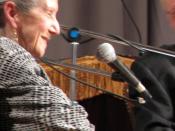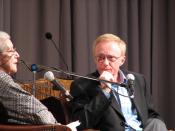All is quiet. An undying heat settles upon the sand as a dry wind silently glides over the earth, creating a volatile mixture of dirt and air. Hardly a sign of life is visible through the thick and oppressive haze. There is only an endless sea of shifting dunes that extends into the horizon, stretching towards eternity. This is the desert, an oasis of nature untouched by society's disregard and the setting for much of Nadine Gordimer's novel The Pickup. Throughout the course of the book, this environment takes on a unique yet equally significant symbolic meaning to the central characters Julie and Ibrahim. The Pickup uses Julie and Ibrahim's interaction with the desert in order to demonstrate the contrasting cultures of both, and thereby gives insight into their mutual struggle for identity in the world.
When Gordimer first introduces the theme of the desert in the novel, the distinct cultures of Julie and Ibrahim as well as their blatant ignorance of these differences becomes apparent.
Julie's only exposure to the vast and barren desert of Ibrahim's country has been through idyllic photographs and imaginings. To her knowledge, the desert is a "picture-postcard place⦠of perpetual heat" (p.153), making Ibrahim "a cut-out from a background that she surely imagines only wrongly. Palm trees, camels, alleys hung with carpets and brass vessels" (p.25). It is not until their shared voyage to Ibrahim's home that Julie is able to distinguish between fact and fiction. Struck by the absence of the familiar palm trees assumed to coat the wasteland, Julie is forced to reevaluate her previous judgment of the man known as Abdu, viewing him truly for the first time as Ibrahim.
However, Ibrahim's encounters with the desert cause his internal struggles with identity to culminate. From the beginning, Ibrahim's total...


